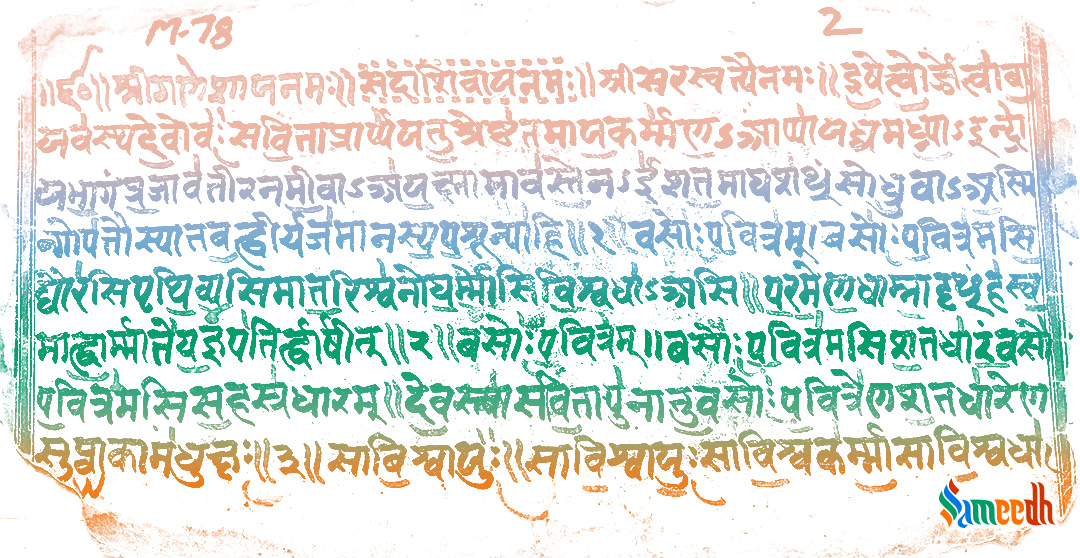Yajurved is an Ancient Sanskrit Vedic text, said to be written in line with Atharvaved and Samved. It is one of the four sacred canonical Hindu books (sruti) known collectively as the Vedas.
Vedas, usually known as impersonal and authorless, are a few of the oldest and sacred most parts of our culture. These oldest-known Vedic Sanskrit texts originated from ancient India and are the scriptures that are used even today in some parts of the world. Unlike Ramayan and Mahabharat, which are Smritis and were written down before they were passed, Vedas are what we call Sruti or that which is heard. They were passed down from generation to generation orally before someone decided to write them down. These were usually narrated or heard by great Sages after years of intense meditation. The earliest of Vedas is credited to have been transmitted since the second millennium BCE. Atharvaveda is the latest Sanskrit Veda to have been added to the collection of Hinduism. It is one of the four sacred canonical Hindu books (sruti) known collectively as the Vedas.

A page from the Vajasneyi samhita found in the Shukla Yajurveda; Image by Ms Sarah Welch
The Breakdown
It is an old Vedic Sanskrit work that contains a collection of ritual-offering phrases recited by a priest while a person conducted ritual actions such as those performed before the yajna fire. Yajurveda is one of Hinduism’s four Vedas and one of its scriptures. Yajurveda’s exact century of writing is unclear but is estimated to be written between 1200 and 800 BCE, making it contemporaneous with Samaveda and Atharvaveda.
The “black” or “dark” (Krishna) Yajurveda and the “white” or “bright” (Shukla) Yajurveda are the two main branches of the Yajurveda. In Yajurveda, the term “black” denotes a “un-ordered, unclear, motley collection” of verses, as opposed to “white,” which denotes a “well-ordered, clear” Yajurveda. Four recensions of the black Yajurveda have survived into contemporary times, while two recensions of the white Yajurveda have.
The earliest and oldest stratum of the Yajurveda Samhita has approximately 1,875 poems that are unique but borrow and build on the foundation of Rigvedic verses. The Satapatha Brahmana, one of the Vedic collection’s largest Brahmana texts, is found in the intermediate stratum. The basic Upanishads, which have influenced numerous schools of Hindu thought, are found in the youngest layer of Yajurveda text. The Brihadaranyaka Upanishad, Isha Upanishad, Taittiriya Upanishad, Katha Upanishad, Shvetashvatara Upanishad, and Maitri Upanishad are among them.

Ashvamedhika Parva of the Mahabharata describes the year-long ceremony according to Yajurveda
Image Source: Internet Archive
The Meaning
Yajurveda differs from the Rigved and Samved Samhitas in terms of character. It is primarily written in prose. In the Yajurveda, the word ‘Yajush’ is explained in a variety of ways. However, one of its definitions states: ‘Gadyatmakam yajuh,’
A ‘Yajuh’ is something written in prose form. Because both phrases are derived from the same root, ‘Yaj,’ another meaning – ‘Yajur Yajateh’ – discusses its relationship with the sacrifice (Yajna). The Yajurveda is more clearly a ritual Veda, as it is mainly a guidebook for the Adhvaryu priest, who had to perform virtually all ritualistic tasks in a sacrifice. From selecting a plot of land for the sacrifice altar to offering oblations to the sacred fires, his labor is diverse. The Yajurveda-Samhitas are the prayer books for the Adhvaryu priest, just as the Samaveda-Samhita is for the Udgata priest. Its main purpose is to be used in sacrifice ceremonies.
The teaching of philosophical principles in the Yajurveda is equally significant. It also promotes the concepts of Prana and Manas. It is frequently cited for representing the Vedic people’s religious and social lives. It’s also recognized for providing geographic information.